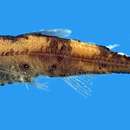Comprehensive Description
(
englanti
)
tarjonnut Smithsonian Contributions to Zoology
Myctophum nitidulum
This large myctophid grows to about 100 mm (Nafpaktitis et al., 1977); the largest specimen caught during the program was 80 mm. Myctophum nitidulum, a tropical-subtropical species (Backus et al., 1977) is common but not abundant in the study area, never being among the 10 most abundant lanternfishes (Table 131). It is represented in the Ocean Acre collections by 543 specimens; 229 were taken during the paired seasonal cruises, 180 of these in discrete-depth samples of which 163 were caught in noncrepuscular tows (Table 23). Myctophum nitidulum was not well sampled by the IKMT; approximately 95 percent of all specimens were caught at night in neuston nets.
DEVELOPMENTAL STAGES.—Postlarvae were 9–16 mm, juveniles 14–42 mm, subadults 44–69 mm, and adults 55–80 mm. Fish less than 27 mm could not be sexed; most of those 27–31 mm and all larger ones were sexed. Males larger than about 35 mm have luminous tissue dorsally on the caudal peduncle, and females larger than about 45 mm have luminous tissue ventrally on the caudal peduncle (Gibbs, 1957). There is no apparent sexual dimorphism in size among the relatively few large specimens (over 40 mm) in the Ocean Acre collections. Males and females were about equally represented among the 67 specimens examined for sex (34 vs 33, respectively).
REPRODUCTIVE CYCLE AND SEASONAL ABUNDANCE.—Spawning occurs from spring to fall, with a peak in intensity in late spring–early summer. The life span may be two or three years, but too few large specimens were caught to be sure. Abundance was greatest in late summer, when most specimens were smaller than 20 mm, and progressively decreased in winter and late spring (Table 120).
Although juveniles predominated in each season, those 14–16 mm were taken only in late spring and late summer. Those smaller than 20 mm were most abundant in late summer. The seasonal distributions of postlarvae (June-October, most in late summer) and adult females (April-September), combined with that of small juveniles, shows that most reproduction takes place in spring and summer.
By late spring spawning had begun, and the catch consisted of recently spawned postlarvae 8–14 mm and juveniles 14–19 mm, fish 28–44 mm presumed to be about one year old, and fish larger than 54 mm about two or more years old. Abundance was dominated by specimens 17–18 mm, which accounted for about 65 percent of the nighttime catch. Adults, although not taken in abundance at any season, were most abundant in late spring.
In late summer recruits 15–19 mm were predominant, accounting for more than 95 percent of the abundance at that season. All specimens caught in discrete-depth samples were 15–28 mm. However, several specimens larger than 60 mm were caught with the Engel trawl at that season, showing that at least two year classes were present. Abundance was greatest at this season (Table 120) as a result of the spawning peak in late spring–early summer.
About 90 percent of the catch in winter was due to juveniles 21–30 mm. Presumably these specimens represented late summer recruits but at an older age. Larger fish were either 34–47 mm or 60–77 mm. These larger specimens probably belonged to different year classes, but their abundance was too low to be certain. The 60–77 mm specimens were at least a year older than the 21–30 mm fish. The age of the 34–47 mm group was uncertain; they may have represented the earliest fish spawned the previous spring.
Additional evidence for a late spring–early summer spawning peak is seen in the catch in September when more than 200 individuals, mostly less than 30 mm, were taken in neuston samples.
VERTICAL DISTRIBUTION.—Little is known about the daytime depth range of M. nitidulum. The five specimens caught in discrete-depth trawls were from 601–950 m, with only postlarvae taken below 850 m (Table 120). Clarke (1973) reported a similar diurnal depth range for M. nitidulum near Hawaii. Gibbs et al. (1971) reported that two 11-mm juveniles were caught at 301–350 m, during the day. This is in error; the fish in question were M. selenops and not M. nitidulum. Fully transformed juveniles of M. nitidulum are not likely to be as small as 11 mm, as transformation occurs at about 14 mm (Moser and Ahlstrom, 1970; H.S. Zadoretzky, personal communication), the size of the smallest juveniles in the Ocean Acre collections.
At night most specimens were caught in neuston nets, and a few were taken at scattered depths down to 950 m (Table 120).
PATCHINESS.—A patchy or clumped distribution was noted at the surface by night in each season. Table 121 gives the number of specimens per hour taken in neuston samples between sunset and sunrise and, despite averaging samples made within one-hour intervals, shows a clumped distribution.
NIGHT:DAY CATCH RATIOS.—Night-to-day catch ratios are 18.0:1 in winter, 20.7:1 in late spring, and 16.4:1 in late summer. The small day catches may have been related to vertical distribution rather than enhanced net avoidance, because most of the night catch (made in neuston nets) in each season consists of fish smaller than 30 mm (Table 120). Presumably fish of this size cannot avoid the IKMT. However, the daytime distribution of this and other species taken in large numbers at night in neuston nets remains a mystery.
- bibliografinen lainaus
- Gibbs, Robert H., Jr. and Krueger, William H. 1987. "Biology of midwater fishes of the Bermuda Ocean Acre." Smithsonian Contributions to Zoology. 1-187. https://doi.org/10.5479/si.00810282.452

